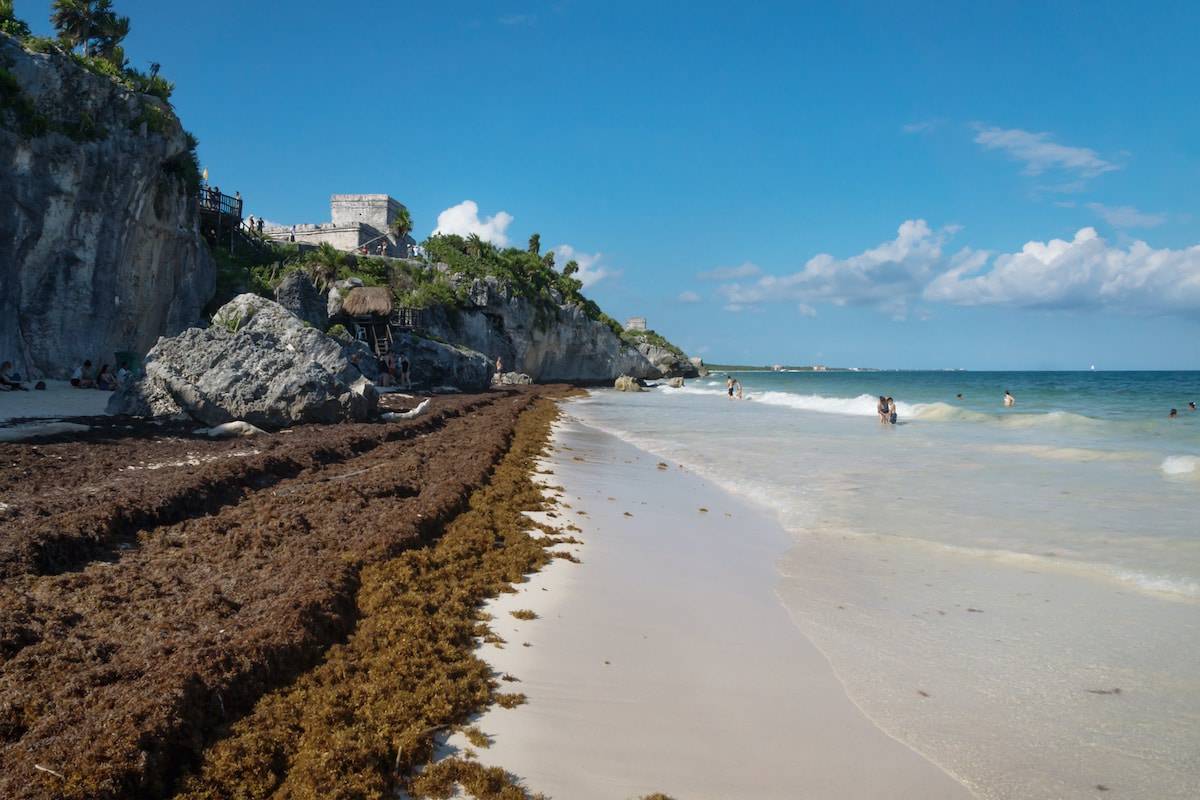As the sargassum season arrives in the Mexican Caribbean, seaweed is covering some of Mexico’s most popular beaches in Cancun, Quintana Roo, and the Riviera Maya.
In the coming weeks, experts predict an undesirable amount of algae will flood Mexico’s beaches.
Which Beaches Will Sargassum Season Affect?
According to the Sargassum Citizen Observatory, sargassum season affected the following beaches in Quintana Roo on March 20:
- Playa Coral
- Riviera Cancun
- Moon Palace
- Royalton Riviera
- Punta Esmeralda
- Playa el Recodo
- Xpu-Ha
- Kantenah
- Akumal
- Bahia
- Principe
- Xcacel-Xcacelito
- Soliman Bay
- Tanka
- Tulum Ruins
- Tulum North Zone
- Punta Piedra
- Tulum ZH South
- Mayan Arch
- Holbox Center
- Punta Molas
- Xhanan Beach
- Bonita Beach
- Mezcalitos Beach
- Punta Morena
- Chen Río Beach
- San Martin Beach
- Bush Beach
- Enchanted Beach
- Punta Celarain

Local media reported that tourism companies are concerned the seaweed may ruin the Easter season. The SPA manager at a beach club inside the national park in Tulum said: “We have a little bit of sargassum beginning to arrive on the beaches of Tulum, although currently, the influx of tourists has dropped a little,”
The manager added: “They hope that during the Easter holidays there is no arrival of sargassum, as this affects the flow of local and foreign visitors.”
The coastal area of Mahahual reported several tonnes of seaweed on the beaches. They said the 1.2 kilometers of mesh applied by the Navy didn’t stop the seaweed.
According to tourist providers, the authorities placed a large protection barrier across the local beaches. However, tonnes of seaweed entered local beaches after they left one part of the beach unprotected.
Marc André, director of Sales & Marketing at the Grand Hyatt Playa del Carmen, said the issue has affected Playa del Carmen for four years. He added: “The Navy has barges to collect the sargassum before it is deposited on the beaches, which is what causes the discomfort, not only visually, but also because of the smell.”
The director stressed the industry has to work together—including hotels and resorts—to stop the seaweed from ruining the tourism sector as the travel industry comes out of the COVID-19 pandemic.
The COVID-19 Situation In Mexico’s Popular Tourism Area’s
Although tonnes of seaweed threatens to spoil Mexico’s stunning beaches, Mexico is one of the most amazing places for North American tourists right now. There are no entry requirements to enter the nation—including zero passenger locator forms.
In addition, Cancun is looking to remove masks in open-air spaces by April. According to State Governor Carlos Joaquín Gonzales, Quintana Roo is readying to relax more restrictions after the region’s success in preserving its ‘green’ status, especially after months of battling an Omicron-led surge.

As stated by Governor Carlos Joaquín Gonzales, the low infection rates registered statewide and the sharp decline in hospitalizations all point towards an easing of the mask mandate by mid-April, provided there are no further COVID-19 increases.
American tourists who have been dreaming of a Cancun getaway for months, if not years, will welcome the news.
In addition, the U.S. State Department has also lowered its travel advisory for Mexico from Level 4 “Do Not Travel” to Level 3 “Reconsider Travel.” The move comes as COVID-19 cases drop nationwide.
The U.S. government issued a new health alert for Mexico, however.
They urged travelers to:
- Watch out for crime in tourism areas.
- Avoid the possession of drugs at all times.
- Be wary of unregulated alcohol.
- Be wary of dangerous currents on Mexican beaches, including beaches in popular tourism areas.
Mexico is currently witnessing its lowest COVID-19 cases in almost one year. The nation recorded a 7-day case average of 3,855 in the last 7 days.

